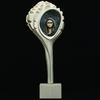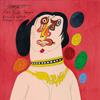A Cavalcade of Ceramics & Glass in All Shapes and Sizes
- NEW YORK, New York
- /
- January 08, 2015

When the 16th edition of The New York Ceramics & Glass Fair (Jan. 21-25) opens its doors at the Bohemian National Hall, 321 East 73rd Street, visitors will be treated to an eye-grabbing array of ceramics and glass, from traditional to avant-garde, offered by an international roster of galleries and private dealers as well as by the artists themselves. The only fair of its kind in the United States, this five-day event has become a mandatory stop for collectors, curators and designers who cherish everything having to do with ceramics and glass. Here is a guide to of some of the fair’s don’t miss offerings:
WHERE: Mark & Marjorie Allen Antiques, (Gilford NH), Booth 3
DON’T MISS: A rare, early 18th century Bristol delft blue dash Archer charger.
WHY: Unlike royal portrait chargers this charger is not of a specific person as most chargers are.
WHERE: Anavian Gallery (New York), Booth 28
DON’T MISS: Roman Period Glass Bowl. Ca. 1st – 4th century. AD
WHY: With its fine shape and iridescence this is a superb example of Roman glass work.
WHERE: Chen Yan Arts (Fu Jian, Fu Zhou Province, China), Third Floor
DON’T MISS: Golden Years, 2011
WHY: Making his debut in America, Professor Chen Yan conceived this piece by using unconventional combinations in handmade glazes, manipulation of chemistry, while utilizing modern technology, and techniques. His idea was to merge his artwork with the deep meaning of oriental art and the romance of western art. This particular piece symbolizes artist’s troubles in life, anger, unfortunate ironies, sorrow, a few happy tears, and rebirth.
WHERE: Martin Chasin Fine Arts (Fairfield, Conn.), Booth 29
MUST-SEE: An18th century Georgian mahogany decanter box.
WHY: With six square bottles, two glasses and a glass tray all hand-painted with gilt decoration, this rare fully equipped traveling set used by titled Englishmen, is in perfect condition.
WHERE: Martin Cohen (New York), Booth 32
MUST-SEE: Bakas 2014, by Jose Arias

WHY: Jose Arias work references his native Dominican Republic’s folklore which protects people and their property. During the day they take on animal forms, but at night they become protective spirits. Each of Arias’ animals reflects this symbolism and spirituality.
WHERE: Martyn Edgell (London), Booth 9
DON’T MISS: English white saltglaze teapot sprigged with a face amongst the scroll work, circa 1760
WHY: The decoration on this teapot has never been seen on any English white saltglaze of this period.
WHERE: Michelle Erickson (Hampton,Virginia), Booth 10
DON’T MISS: American Pickle Stand, 2014
WHY: Steeped in 18th century historical reference American Pickle Stand makes a 'loaded' statement on 21st century gun culture in America Erickson evokes the historical precedent of ceramics used to advocate for social and political change, here making a pointed commentary on the overt power and influence of the gun lobby in Congress.
WHERE: Jeffrey Evans & Associates (Mt. Crawford, Virginia), Booth 13
DON’T MISS: An American signed Dietz cut-overlay kerosene banquet lamp, circa 1860
_Tollbooths_FC500x366.jpg)
WHY: American kerosene-period lighting that is signed by its manufacturer is extremely rare. Dietz & Company of New York City was the largest, and most important/prolific manufacturer and innovator of lighting devices in the United States during the 19th and 20th centuries.
WHERE: Ferrin Contemporary (Cummington, Mass.), Booth 6 and 3rd Floor
DON’T MISS: The Patience Flower series, by Vipoo Srivilasa, part of MADE IN CHINA exhibition.
WHY: During a residency at the Pottery Workshop in Jingdezhen China, Srivilasa met a famous flower maker, one of the countless artisans who participate in the process of producing porcelain sculpture designed by artists. Typically up to 30 skilled artisans are involved in the production of an object including clay maker, sculptors, mold makers, transporters, kiln masters, box makers. The flower maker works independently adorning the bear molds with various patterns based on drawings by Srivilasa.
WHERE: Haggerty Ceramics (Haggerty California), Booth 33
DON’T MISS: Flowing Orange Matte and Gun Metal Glaze Vase, 2014, Santa Barbara, California
WHY: This vessel is made with rare materials that are native to California. It is an excellent example of how the combination of the right form, and unique glazes that are juxtaposed in color and texture, work together to create a well-integrated piece.
WHERE: Katherine Houston (Boston, Massachusetts) Booth, 14
DON’T MISS: Summer Splendor is an outstanding centerpiece with a plethora of summer vegetables.
WHY: Using 18th century porcelain techniques, Ms. Houston creates ceramics in a contemporary idiom.
WHERE: Iliad (New York), Third Floor
DON’T MISS: The Three Mothers (Aleph Mem Shin), a glazed ceramic and glass mosaic diptych by Andrea Zemel, 2013 74.3"h x 36.5”w
WHY: The luminous and allegorical mosaics of Andrea Zemel imagine the play of the world in terms of the tales we choose to tell about ourselves. Evoking the traditions of illuminated manuscript in her narratives, they are at once symbolic and decorative, with great concern for craft as a vehicle for content. In her symbolic landscape of churning vortices, "Three Mothers" is a visual parable for the Wave.
WHERE: Iznik Classics (Istanbul), Booth 12
DON’T MISS: An Iznick black-and-white jar with “Tombak” (gilded copper), 2014
WHY: There is no other Iznik style piece in this size, form and color, as they generally have been manufactured in multi-colors or blue and white. The ceramics of Iznik were among the finest works of art produced in the Ottoman Empire.
WHERE: Leo Kaplan Ltd. (New York), Booth 4DON’T MISS: Rare English Saltglaze Stoneware With Oriental Motifs, Circa 1750-60WHY: All five pieces are rare because of their beautiful shape and subject matter. The lighthouse shape coffee pot is one of only a handful of known examples. The pitcher is painted with a very rare pattern, an Oriental bird seller. All the pieces are decorated with Oriental motifs taken from Chinese ceramics.
WHERE: Polly Latham Asian Art (Boston, Mass.), Booth 34
DON’T MISS: An exceptionally fine and rare pair of early 18th century Chinese Export Porcelain Famille Verte wine coolers with green lion's head masks, meticulously painted with borders representing air and water, embellished with fish, crayfish and birds.
WHY: It is exceedingly rare to find a pair of wine coolers from the Kangxi period.
WHERE: Lee Gallery & Studio (Stevens, Pennsylvania), Booth 8
DON’T MISS: A pair of Prickly Melons with Imperial Yellow Glaze, 2014, USA, Porcelain with incised and applied decoration under Imperial Yellow glaze.
WHY: Cliff Lee’s work can be seen at The White House permanent collection of American Crafts, as well in the permanent collection of the Smithsonian American Art Museum’s Renwick Gallery, and The Metropolitan Museum of Art. He spent more than seventeen years trying to unlock the secret of the yellow Chinese Imperial glaze, so named for its high position in the Ming court beginning in the fifteenth century. Through painstaking experiments I was able to recreate the Imperial Yellow glaze in objects such as Prickly Melons. The stems of the melons were created through the painstaking application of small bits of clay.
WHERE: Moylan Smelkinson (Baltimore, Maryland), Booth 24
DON’T MISS: Worcester Porcelain Dessert Dish, Flight & Bar period, circa 1795.
WHY: The Worcester factory was a highly respected producer of soft paste porcelain in England during the 18th century. The earliest designs were either copies or adaptations of Chinese, Japanese, French or Meissen Patterns. What makes this piece important is that it is one of the best examples of a new direction in creative design at the Worcester Factory, a striking departure of their artists from the traditional motifs. This finely painted dessert dish is richly decorated in Japan colors with a stylized Japanese garden scene in a rare pattern known as "Clematis".
WHERE: John Pagliaro (New York), Third Floor
DON’T MISS: As Red as Black is, 2014 Manganese Ceramic pinch pots with red glaze in a reclaimed lumber frame, (stainless steel stand-offs, 97% optically accurate acrylic)
WHY: Following on the heels of a breakthrough year for the artist, John Pagliaro's most recently completed large-scale masterwork combines equal parts seduction and danger leaving viewers compelled and moved, one is inevitably drawn in by the artwork's raw force and power.
WHERE: Polka Dot Antiques (Waccabuc, NY), Booth 15
DON’T MISS: A Rare Staffordshire Pearlware Table Base Group of ‘The Death of Munroe,’ 1820/30, in the manner of Obadiah Sherratt, modeled as a large tiger attacking the stricken Lieutenant Munroe, on rectangular base with bracket feet, the title inscribed to two oval plaques, 14 ½“ x 11” high.
WHY: This is one of the rarest early Staffordshire Table Base groups and is considered one of the ‘must have’ items amongst collectors of Staffordshire figures.
WHERE: Sylvia Powell Decorative Arts (London), Booth 5
DON’T MISS: IL VOLTO, Pablo Picasso (1881-1973) circa 1960
WHY: Egidio Costantini, a major force in the world of glass-blowing who collaborated with some of the greatest artists of the 20th century, was introduced to Picasso at his home in Vallauris in 1954. Picasso was very interested in the opportunities offered by glass as an art medium. Their friendship lasted until Picasso's death in 1973. Picasso pushed Costantini to the limits of creativity, demanding that he create pieces that defied the laws of mechanics and were seemingly impossible to create in glass.
WHERE: Santos (London), Booth 7
DON’T MISS: Pair of large mid-17th century Chinese export porcelain “smiling twins,” early Kangxi reign, Qing dynasty
WHY: The two laughing boys are known in China as the two immortals of Harmony and Union. According to Confucian philosophy, abundant male offspring was considered essential to perform the duties of the family in society and the rituals and sacrifices for the deceased ancestors. Since sons guaranteed the survival of the family name, the depiction of boys as a form of wishing many sons became popular motif on Chinese porcelain, textiles and lacquer-ware since the Early Ming dynasty on the 15th century.
WHERE: TOJ Gallery (Annapolis Maryland), Booth 19
DON’T MISS: Rare Longwy Boule Coloniale," Les Baigneuses" designed by Jean Olin, nee Sigismund Olesiewicz, a Polish/Russian artist who emigrated to France in the early 1900s and designed for Låongwy and Primavera. Our vase is number 13/150 and dates to circa 1949.
WHY: This vase is the essence of French art deco design. From 1920 through the 40s during the art deco period, Longwy artist-designed enamels were steeped in this new artistic movement, which were sourced in modernism, cubism and abstraction. The designer of the boule was a man named Sigismund Olesiewicz, who like many eastern European artists of the time made his way to Paris where he changed his name to Jean Olin. His vase incorporates all the design elements of the art deco period with stunning affect.
WHERE: Earle D. Vandekar of Knightsbridge (New York), Booth 16
DON’T MISS: A late 18th-early19th century large Portuguese Pottery Duck Tureen, Royal China Works, Real Fabrica da Louca Factory in Lisbon,
WHY: An incredibly rare life-sized model of a duck standing on a cream and green mottled hollow base in cream, green, ochre and light gray, this rare trompe l'oeil tureen in the form of a life sized duck is just spectacular in form and execution from an important European maker.
WHERE: Antiques Van Geenen (Delft, Holland), Booth 11
DON’T MISS: This set of 18th century Delft white horses are small, were made in Delft, The Netherlands around 1750.
WHY: It is quite difficult to find a pair of horses with one facing left side and one to the right.
WHERE: Maria and Peter Warren Antiques (Wilton, Conn.), Booth 23
DON’T MISS: English Saltglaze Drabware Tea Pot on three mask and paw feet.
WHY: This is a very rare example because there wasn't much drabware that was made at the time and very little of it survived. It is in wonderful condition and has great provenance as having been part of one of the great collections of English 18th and 19th Century ceramics.
WHERE: Mark J. West (Redhill, England), Booth 20
DON’T MISS: A tall German goblet, circa 1730
WHY: It is very unlikely that any glass could withstand a serious fire as this goblet has done. Its unique color and shape are borne from the fact that it survived such high temperatures.
About The New York Ceramics & Glass Fair
Featuring 35 decorative arts specialists, The New York Ceramics & Glass Fair, which takes place on three floors of the Bohemian National Hall, 321 East 73rd Street (between First and Second Avenues), opens to the public on Wednesday, January 21, and runs through Sunday, January 25. Hours are 11 a.m. to 7 p.m. Wednesday through Saturday, and on Sunday from 11 a.m. to 4 p.m. Tickets, including catalog, are $20 per person and can be used throughout the duration of the fair.
As always, the New York Ceramics & Glass Fair will present a series of informative lectures by prominent experts and design authorities, and will host a loan exhibition organized by the Czech Center New York in collaboration with the Bohemian Benevolent and Literary Association It’s Always Teatime in Wonderland, showcases Czech and Slovak designers who use everyday objects as a starting point of their explorations to re-create and reimagine the world of fairytales and fantasy. The exhibition combines established designers, such as Jakub Berdych, Radka Kovačiková, Věra Panková and Maxim Velčovský, with an emerging younger generation of artists who make their U.S. debut: Kristýna Bratránková, Lucie Kovačiková, Jolana Sornerová, Helena Tapajnová, and Hana Vinklárková.
The New York Ceramics & Glass Fair is produced by MCG Events LLC and Caskey Lees Inc. In addition to the New York Ceramics and Glass Fair, Caskey-Lees currently produces the San Francisco Tribal & Textile Arts Show in San Francisco.
For more information visit: www.newyorkceramicsand glassfair.com.
















